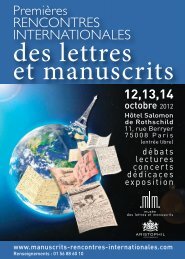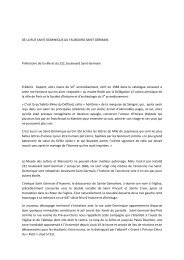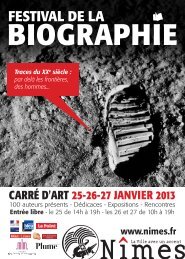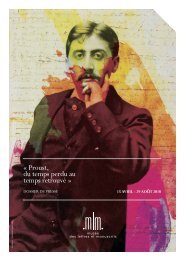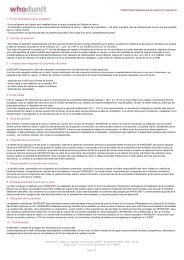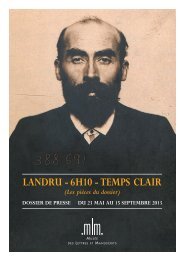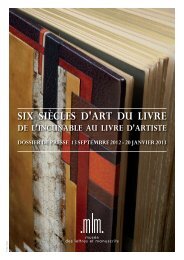Le dossier de presse - Musée des lettres et manuscrits
Le dossier de presse - Musée des lettres et manuscrits
Le dossier de presse - Musée des lettres et manuscrits
Create successful ePaper yourself
Turn your PDF publications into a flip-book with our unique Google optimized e-Paper software.
PRESS PACK<br />
9<br />
III. THE EXHIBITION ROUTE<br />
With the notable exception of the Simenon Collection of the University of Liège (which contributed<br />
scientifi cally to this exhibition, particularly in regard to the writer life), the Museum of l<strong>et</strong>ters<br />
and manuscripts of Brussels owns the most important collection of works and manuscripts<br />
of the author from Liège.<br />
The exhibition, whose exhibition curator is Jean-Christophe Hubert, will be composed of eight parts<br />
presented below.<br />
A childhood in Liège and the <strong>de</strong>parture to Paris<br />
This fi rst part of the exhibition called “A childhood in Liège and the <strong>de</strong>parture to Paris” presents a l<strong>et</strong>ter<br />
from painter Vlaminck dated from 24 March 1934 which <strong>de</strong>als with the Stavisky case, in which the painter<br />
talks about “Simenon in search of Prince’s mur<strong>de</strong>rers” and adds “There is here som<strong>et</strong>hing that I don’t<br />
like. The real policemen, those who make the nasty job to earn a living, have to take a dim view of it,<br />
and the mur<strong>de</strong>rers have to think that Simenon must mind his own business, that is to say, writing books”.<br />
In fact, Simenon, then a journalist in Paris where he me<strong>et</strong>s with artists such as Vlaminck, Picasso, Max<br />
Jacob and Joséphine Baker (with whom he would have one of the most extramarital relationships that<br />
has brighten up his home life), took an interest in the mysterious Stavisky case, and led, quite badly, an<br />
investigation following the suici<strong>de</strong> of the swindler and the suspicious <strong>de</strong>ath of Albert Prince, on behalf of<br />
the newspaper Paris-Soir. Tricked by informers from this background, he published articles that could<br />
not be taken seriously and did not come out of this investigative journalism experience.<br />
Georges Simenon and Liège<br />
From the beginning of the Simenon's career and throughout the latter, many documents showed the<br />
close links that he kept with his hom<strong>et</strong>own, and particularly his consi<strong>de</strong>ration for his mother, his regular<br />
r<strong>et</strong>urns in Liège, his interest for the town and his friends from this place.<br />
Georges Simenon and Tigy Renchon<br />
In the part <strong>de</strong>dicated to “Georges Simenon and Tigy Renchon”, we discover a l<strong>et</strong>ter from Régine Renchon,<br />
"Tigy", sent to her brother Yvan, who would regularly be responsible for his brother-in-law's business and<br />
editions (the relation b<strong>et</strong>ween both men were closed, as witnessed by the numerous l<strong>et</strong>ters preserved<br />
in the Museum of l<strong>et</strong>ters and manuscripts).<br />
In March 1923, Simenon married Régine Renchon, whom he m<strong>et</strong> insi<strong>de</strong> a more or less fringed artists'<br />
group, in the church Sainte-Véronique of Liège. The religious ceremony was precipitated and Simenon<br />
took the train to Paris on the same evening with "Tigy". His wife's presence next to him reassures Simenon<br />
who called her a crash barrier who prevented him from sinking into excess. The short stories that he<br />
wrote every night (often two or three), were quickly a success. Tigy has accompanied Simenon for many<br />
years, and particularly those that were marked by the beginning of his great success.



